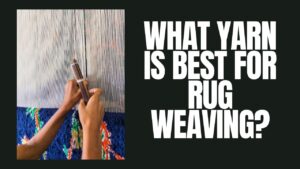When it comes to textile crafts, yarn plays a pivotal role in determining the final look, feel, and durability of a project. But not all yarns are created equal. One of the most common questions among beginners and seasoned crafters alike is: “What’s the difference between rug yarn and regular yarn?” While both serve creative purposes, these two yarn types differ in texture, durability, fiber composition, and usage. This article will explore these distinctions in depth, helping you choose the right yarn for your next project.
1. Understanding Rug Yarn
Rug yarn is a specially designed type of yarn created specifically for rug making. Its construction is meant to withstand heavy foot traffic, abrasion, and wear and tear over time. Typically, rug yarn is:
- Thicker and heavier than regular yarn
- Made from durable materials such as acrylic, wool, or polyester
- Often tightly twisted or spun to minimize fraying
- Sometimes coated with a slight sheen or coarseness for added durability
Rug yarn is primarily used in latch hook rugs, punch needle rugs, braided rugs, and tapestry crafts. Due to its bulky and robust nature, it holds its shape better and resists flattening when walked on or vacuumed.
2. Understanding Regular Yarn
Regular yarn, on the other hand, is a general-purpose yarn used in a broad spectrum of projects, including knitting, crocheting, weaving, and embroidery. It comes in various weights (thicknesses), textures, fiber types, and finishes. Depending on your project, you might choose regular yarn for:
- Apparel like scarves, sweaters, and hats
- Home décor such as blankets, pillows, or wall hangings
- Toys and accessories
- Amigurumi or baby items
Regular yarns range from ultra-fine lace weight to bulky or super bulky and are designed with comfort, color variety, and flexibility in mind.
3. Key Differences Between Rug Yarn & Regular Yarn
To better understand how rug yarn and regular yarn differ, let’s compare them side by side:
| Aspect | Rug Yarn | Regular Yarn |
|---|---|---|
| Purpose | Designed for rugs and heavy-duty projects | Used in general crafts like knitting, crochet, etc. |
| Durability | Highly durable, withstands foot traffic and pressure | Moderate to high, depending on fiber and twist |
| Texture | Coarse, stiff, and strong | Softer, more flexible, comfortable for skin contact |
| Weight/Thickness | Usually bulky or extra bulky | Ranges from lace to super bulky |
| Fiber Types | Wool, acrylic, polyester blends | Cotton, bamboo, wool, acrylic, blends |
| Twist/Tension | Tight twist, minimal fraying | Varies – can be loose, soft, or tight |
| Finish | Matte or slight sheen, resistant to dirt | Matte, glossy, metallic, or fuzzy options |
| Elasticity | Low to moderate | Varies based on fiber type (e.g., wool is elastic) |
| Color Variety | Limited compared to regular yarn | Wide range of colors, patterns, and effects |
| Cost | Generally more expensive per yard | Varies widely, from inexpensive to luxury yarns |
4. Project Suitability: When to Use Which Yarn
Rug Yarn is ideal for:
- Latch hook rugs
- Punch needle rugs
- Macrame rugs
- Braided rugs
- Wall hangings with texture
- Durable floor mats
Because it’s made for toughness, rug yarn won’t fray or degrade quickly, even with regular vacuuming or heavy foot traffic.
Regular Yarn is ideal for:
- Scarves, hats, and gloves
- Sweaters and cardigans
- Shawls and wraps
- Baby garments and accessories
- Decorative pillows and throws
- Lightweight wall hangings
Regular yarn offers versatility and comfort. You wouldn’t want to wear something made of rug yarn – it’s just not cozy or soft enough!
5. Can They Be Interchanged?
In most cases, interchanging rug yarn with regular yarn is not advisable, especially if the final product is expected to serve a specific function.
- Using regular yarn in a rug-making project may result in a rug that frays, stretches out, or wears down too quickly.
- Using rug yarn in a sweater or scarf would likely produce a stiff, scratchy, and uncomfortable garment.
That said, some creative textile artists do experiment across boundaries. For example, rug yarn can be used in statement wall art or woven sculptures, where structural strength is needed. Just make sure the yarn’s properties suit the project’s purpose.
6. Availability and Brands
You can find rug yarn and regular yarn in most large craft stores or online retailers. Here are examples of each:
- Popular Rug Yarn Brands: Red Heart Classic Rug Yarn, Herrschners Rug Yarn, Craft Coats
- Popular Regular Yarn Brands: Lion Brand, Bernat, Caron, Cascade Yarns, Patons
Rug yarn tends to come in shorter yardage per skein because it’s thicker, while regular yarn offers variety packs or longer skeins for larger garments or accessories.
7. Care Instructions
Because of its synthetic or wool-blend construction, rug yarn is often machine washable, but it may have specific instructions like cold water only or no tumble drying.
Regular yarn care depends on the fiber:
- Cotton can be washed and dried
- Wool often needs hand washing or gentle cycles
- Acrylic is generally low-maintenance
Always check the yarn label for care details before you begin a project.
Can I use rug yarn for knitting or crochet?
Technically yes, but it’s stiff and not ideal for garments. It’s better suited for heavy, textured items like rugs or wall art.
Is rug yarn more expensive than regular yarn?
It can be, due to its thicker material and durability. However, its usage is typically limited to smaller surface area projects like rugs or mats.
What size hook or needle should I use with rug yarn?
Use larger hooks or needles (sizes K to N or higher) to accommodate the bulk. Always check your pattern recommendations.
Conclusion
While rug yarn and regular yarn may look similar at a glance, their differences are significant. Rug yarn is engineered for strength, durability, and structure, making it perfect for rugs and home décor with high use. Regular yarn, on the other hand, offers versatility, comfort, and aesthetic appeal for a wide range of craft projects.
Understanding these distinctions ensures that your handmade projects not only look beautiful but also serve their intended purpose effectively and last longer. So, whether you’re punching a rug or crocheting a cozy scarf, choosing the right yarn makes all the difference.



